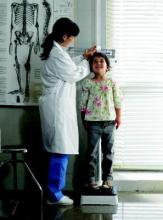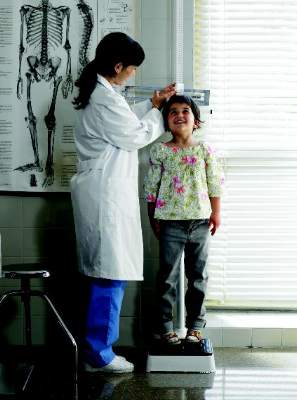User login
The value of the patient-centered medical home model has become a little bit clearer thanks to results from a randomized clinical trial that showed improved outcomes and lower costs for high-risk children treated in the patient-centered medical home setting, although more work is needed to understand the broad implications.
The trial focused on high-risk children with chronic illness and measured a variety of outcomes for those receiving comprehensive care (105 patients) versus those receiving usual care (95 patients), with a secondary outcome of the trial focused on the cost to treat these patients. Results were published Dec. 23 in JAMA (2014;312:2640-8 [doi:10.1001/jama.2014.16419]).
Comprehensive care was provided at the University of Texas, Houston High-Risk Children’s Clinic, which served as the medical home. It included treatment from primary care clinicians and specialists in the same clinic with multiple features to promote prompt, effective care. Usual care was provided locally in private offices or in the university general pediatrics clinic without modification.
In an intent-to-treat analysis, the rate of serious illness among children receiving comprehensive care was 10 per 100 child-years, compared with 22 for children receiving usual care (rate ratio, 0.45). Hospital and clinic costs for the comprehensive care group also were lower – $16,523 per child year, compared with $26,781 for the usual care group (cost ratio, 0.58).
Other outcomes that were improved for the comprehensive care group versus the usual care group were total serious illness (16 per 100 child-years vs. 44), emergency department visits (90 vs. 190), hospitalizations (69 vs. 131), number of days in the hospital (276 vs. 635), ICU admissions (9 vs. 26) and days in the ICU (28 vs. 103). However, deaths were not significantly reduced in the comprehensive care arm (2 per 100 child-years vs. 3; P = .40).
Researchers attributed cost savings in the comprehensive care group to lower hospital costs.
“The benefits and cost savings we identified with comprehensive care seem likely to be achievable only in high-risk populations treated in major academic centers with the subspecialists, resources, and clinician commitment to provide such care,” Dr. Ricardo A. Mosquera a pediatrician at the University of Texas in Houston, and his colleagues wrote. “These findings from a single site of selected patients with a limited number of clinicians require study in larger, broader populations before conclusion about generalizability to other settings can be reached.”
For high-risk, high-cost health care users, particularly in the pediatric setting, evidence is building that offering comprehensive care services can improve outcomes at lower costs. But questions linger as to whether that can translate to a broader population.
To achieve both improved outcomes and lower costs with high-risk high utilizers, regular, almost daily contact with patients is critical, notes Dr. James Perrin, president of the American Academy of Pediatrics. It also needs to be comprehensive and meet the needs of the patient and requires an intimate knowledge of the patient by physicians and their families.
These criteria “raise questions about financial returns from expanding programs to adult populations with less hospital and emergency department use: Will comprehensive medical home models and care coordination show cost savings for older patients with chronic conditions but little risk of high-cost use? Where such cost improvements exist, they should lead to better practice arrangements, but many more patients can benefit from medical homes, although evidence is needed from sources other than short-term savings alone.”
Dr. James Perrin of Harvard Medical School and MassGeneral Hospital for Children, both in Boston, is president of the American Academy of Pediatrics. His term ends on Dec. 31, 2014. His comments were made in an editorial accompanying the study (JAMA 2014;312:2625-6).
For high-risk, high-cost health care users, particularly in the pediatric setting, evidence is building that offering comprehensive care services can improve outcomes at lower costs. But questions linger as to whether that can translate to a broader population.
To achieve both improved outcomes and lower costs with high-risk high utilizers, regular, almost daily contact with patients is critical, notes Dr. James Perrin, president of the American Academy of Pediatrics. It also needs to be comprehensive and meet the needs of the patient and requires an intimate knowledge of the patient by physicians and their families.
These criteria “raise questions about financial returns from expanding programs to adult populations with less hospital and emergency department use: Will comprehensive medical home models and care coordination show cost savings for older patients with chronic conditions but little risk of high-cost use? Where such cost improvements exist, they should lead to better practice arrangements, but many more patients can benefit from medical homes, although evidence is needed from sources other than short-term savings alone.”
Dr. James Perrin of Harvard Medical School and MassGeneral Hospital for Children, both in Boston, is president of the American Academy of Pediatrics. His term ends on Dec. 31, 2014. His comments were made in an editorial accompanying the study (JAMA 2014;312:2625-6).
For high-risk, high-cost health care users, particularly in the pediatric setting, evidence is building that offering comprehensive care services can improve outcomes at lower costs. But questions linger as to whether that can translate to a broader population.
To achieve both improved outcomes and lower costs with high-risk high utilizers, regular, almost daily contact with patients is critical, notes Dr. James Perrin, president of the American Academy of Pediatrics. It also needs to be comprehensive and meet the needs of the patient and requires an intimate knowledge of the patient by physicians and their families.
These criteria “raise questions about financial returns from expanding programs to adult populations with less hospital and emergency department use: Will comprehensive medical home models and care coordination show cost savings for older patients with chronic conditions but little risk of high-cost use? Where such cost improvements exist, they should lead to better practice arrangements, but many more patients can benefit from medical homes, although evidence is needed from sources other than short-term savings alone.”
Dr. James Perrin of Harvard Medical School and MassGeneral Hospital for Children, both in Boston, is president of the American Academy of Pediatrics. His term ends on Dec. 31, 2014. His comments were made in an editorial accompanying the study (JAMA 2014;312:2625-6).
The value of the patient-centered medical home model has become a little bit clearer thanks to results from a randomized clinical trial that showed improved outcomes and lower costs for high-risk children treated in the patient-centered medical home setting, although more work is needed to understand the broad implications.
The trial focused on high-risk children with chronic illness and measured a variety of outcomes for those receiving comprehensive care (105 patients) versus those receiving usual care (95 patients), with a secondary outcome of the trial focused on the cost to treat these patients. Results were published Dec. 23 in JAMA (2014;312:2640-8 [doi:10.1001/jama.2014.16419]).
Comprehensive care was provided at the University of Texas, Houston High-Risk Children’s Clinic, which served as the medical home. It included treatment from primary care clinicians and specialists in the same clinic with multiple features to promote prompt, effective care. Usual care was provided locally in private offices or in the university general pediatrics clinic without modification.
In an intent-to-treat analysis, the rate of serious illness among children receiving comprehensive care was 10 per 100 child-years, compared with 22 for children receiving usual care (rate ratio, 0.45). Hospital and clinic costs for the comprehensive care group also were lower – $16,523 per child year, compared with $26,781 for the usual care group (cost ratio, 0.58).
Other outcomes that were improved for the comprehensive care group versus the usual care group were total serious illness (16 per 100 child-years vs. 44), emergency department visits (90 vs. 190), hospitalizations (69 vs. 131), number of days in the hospital (276 vs. 635), ICU admissions (9 vs. 26) and days in the ICU (28 vs. 103). However, deaths were not significantly reduced in the comprehensive care arm (2 per 100 child-years vs. 3; P = .40).
Researchers attributed cost savings in the comprehensive care group to lower hospital costs.
“The benefits and cost savings we identified with comprehensive care seem likely to be achievable only in high-risk populations treated in major academic centers with the subspecialists, resources, and clinician commitment to provide such care,” Dr. Ricardo A. Mosquera a pediatrician at the University of Texas in Houston, and his colleagues wrote. “These findings from a single site of selected patients with a limited number of clinicians require study in larger, broader populations before conclusion about generalizability to other settings can be reached.”
The value of the patient-centered medical home model has become a little bit clearer thanks to results from a randomized clinical trial that showed improved outcomes and lower costs for high-risk children treated in the patient-centered medical home setting, although more work is needed to understand the broad implications.
The trial focused on high-risk children with chronic illness and measured a variety of outcomes for those receiving comprehensive care (105 patients) versus those receiving usual care (95 patients), with a secondary outcome of the trial focused on the cost to treat these patients. Results were published Dec. 23 in JAMA (2014;312:2640-8 [doi:10.1001/jama.2014.16419]).
Comprehensive care was provided at the University of Texas, Houston High-Risk Children’s Clinic, which served as the medical home. It included treatment from primary care clinicians and specialists in the same clinic with multiple features to promote prompt, effective care. Usual care was provided locally in private offices or in the university general pediatrics clinic without modification.
In an intent-to-treat analysis, the rate of serious illness among children receiving comprehensive care was 10 per 100 child-years, compared with 22 for children receiving usual care (rate ratio, 0.45). Hospital and clinic costs for the comprehensive care group also were lower – $16,523 per child year, compared with $26,781 for the usual care group (cost ratio, 0.58).
Other outcomes that were improved for the comprehensive care group versus the usual care group were total serious illness (16 per 100 child-years vs. 44), emergency department visits (90 vs. 190), hospitalizations (69 vs. 131), number of days in the hospital (276 vs. 635), ICU admissions (9 vs. 26) and days in the ICU (28 vs. 103). However, deaths were not significantly reduced in the comprehensive care arm (2 per 100 child-years vs. 3; P = .40).
Researchers attributed cost savings in the comprehensive care group to lower hospital costs.
“The benefits and cost savings we identified with comprehensive care seem likely to be achievable only in high-risk populations treated in major academic centers with the subspecialists, resources, and clinician commitment to provide such care,” Dr. Ricardo A. Mosquera a pediatrician at the University of Texas in Houston, and his colleagues wrote. “These findings from a single site of selected patients with a limited number of clinicians require study in larger, broader populations before conclusion about generalizability to other settings can be reached.”
FROM JAMA
Key clinical point: Treatment using the patient-centered medical home model improved outcomes at lower costs than usual care for high-risk children.
Major finding: The rate of serious illness for children receiving comprehensive care was 10 per 100 child-years, compared with 22 for usual care.
Data source: A randomized, controlled trial of high-risk children with chronic illness (three or more emergency department visits, two or more hospital visits, or one or more pediatric ICU visits in the previous year) treated at the University of Texas, Houston, high-risk clinic randomly assigned to receive comprehensive care in a patient-centered medical home model (n=96,105) or usual care (n=96). Enrollment in the study was between March 2011 and February 2013, with outcomes measured through Aug. 31, 2013.
Disclosures: Trial was initially funded by the University of Texas Health Science Center at Houston, with subsequent grants coming from the Centers for Medicare & Medicaid Services, Texas Health and Human Services, and the National Center for Advancing Translational Sciences. Report author Dr. Guy Clifton reported receiving fees from Clifton Health Centers LLC. No other disclosures were reported.

